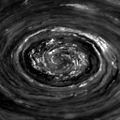Giant planet facts for kids
Giant planets are super big planets! They are much larger and more massive than Earth. In our Solar System, giant planets are either gas giants, like Jupiter and Saturn, or ice giants, like Uranus and Neptune. These huge worlds are mostly made of light elements like hydrogen and helium, or icy materials, instead of rock like Earth.
Contents
What Makes a Planet "Giant"?
Giant planets are named for their enormous size and mass. They are so big that you could fit many Earths inside them! For example, Jupiter is so large that over 1,300 Earths could fit inside it. These planets don't have a solid surface like Earth does. If you tried to land on one, you would just sink into its thick atmosphere.
Gas Giants: Jupiter and Saturn
The two gas giants in our Solar System are Jupiter and Saturn. They are mostly made of hydrogen and helium gas. Deep inside, the pressure is so intense that hydrogen turns into a strange liquid form called metallic hydrogen. This metallic hydrogen acts like a metal and can conduct electricity.
Jupiter: The King of Planets
Jupiter is the largest planet in our Solar System. It's famous for its Great Red Spot, which is a giant storm bigger than Earth that has been raging for hundreds of years! Jupiter has a very strong magnetic field and many moons, including the four largest ones discovered by Galileo: Io, Europa, Ganymede, and Callisto. Some of these moons might even have oceans under their icy surfaces.
Saturn: The Ringed Jewel
Saturn is well-known for its stunning system of bright rings. These rings are made of billions of tiny pieces of ice and rock, ranging from dust-sized particles to chunks as big as a house. Saturn is the second-largest planet and also has many moons, with Titan being the biggest. Titan is special because it has a thick atmosphere and lakes of liquid methane on its surface.
Ice Giants: Uranus and Neptune
Uranus and Neptune are called ice giants because they contain a lot of "ices." These aren't just frozen water, but also frozen methane and ammonia. Unlike gas giants, ice giants have a smaller amount of hydrogen and helium. They have a rocky core surrounded by a thick layer of icy, slushy material.
Uranus: The Sideways Planet
Uranus is unique because it spins on its side! Its axis is tilted almost 90 degrees compared to its orbit around the Sun. Scientists think a huge collision early in its history might have caused this extreme tilt. Uranus also has faint rings and many moons. It has a blue-green color because of the methane in its atmosphere, which absorbs red light.
Neptune: The Blue Wanderer
Neptune is the farthest planet from the Sun in our Solar System. It's a deep blue color, even bluer than Uranus, due to more methane in its atmosphere. Neptune is known for its incredibly strong winds, which are the fastest in the Solar System. Like Jupiter, it also had a Great Dark Spot, a storm similar to Jupiter's Great Red Spot, though it has since disappeared. Neptune has a few rings and many moons, with Triton being the largest.
How Do Giant Planets Form?
Scientists believe giant planets form in a few ways. One idea is called "core accretion." This is where a solid core of rock and ice forms first, growing larger and larger. Once it gets big enough, its gravity becomes strong enough to pull in huge amounts of gas from the surrounding disk of dust and gas around a young star. This gas then forms the planet's thick atmosphere. Another idea is "disk instability," where parts of the gas and dust disk around a young star become unstable and collapse directly to form a giant planet.
Do Other Stars Have Giant Planets?
Yes! Scientists have discovered thousands of planets orbiting other stars, called exoplanets. Many of these exoplanets are giant planets, some even bigger than Jupiter. Some of these "exogiants" are called "hot Jupiters" because they orbit very close to their stars, making them extremely hot. Studying these distant giant planets helps us understand how planets form and evolve in different star systems.
Images for kids
-
These cut-aways illustrate interior models of the giant planets. Jupiter is shown with a rocky core overlaid by a deep layer of metallic hydrogen.
See also
 In Spanish: Planeta gigante para niños
In Spanish: Planeta gigante para niños






